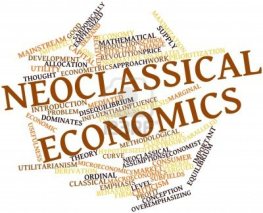
RECOMMENDED READING
Oren Cass’s essay demonstrates how the advantages of industrial policy, apparent to some of the founders of economics and foundational to the success of the United States, were carefully airbrushed out by advocates of free trade in the 20th century. But he goes too easy on the neoclassical economists. Not only did their defenses of trade and attacks on industrial policy rely on intentional misrepresentations of economic theory, but the actual international trade system never met the bar required by their own theory to be considered beneficial.
Neoclassical economists relish the elegant simplicity of David Ricardo’s theory of comparative advantage, which slots neatly into standard models of production, supply, and demand. Using the standard model, any economics undergraduate can produce a “proof” that free trade results in an absolute increase in social welfare, as each society focuses on producing the goods and services it is best at making.
But of course, an enterprising student is likely to raise his hand to point out that free trade leads to all sorts of obvious social welfare losses: jobs lost, factories shuttered, people displaced, and so on. At which point his professor will point to two key assumptions in the model: that the balance of trade and currency purchasing power reach a new long-term equilibrium, and that “losers” from trade are fully compensated for their losses by the gains from trade. The experience of globalization suggests that neither assumption is easily met in practice.
First, consider the case of opening of trade with China. Neoclassical economists believed that the assumptions underlying their model for free trade would be met in the case of China: the trade balance and currency purchasing power would reach a long-term equilibrium.
Despite some conciliatory currency reforms undertaken to grease the path towards WTO accession, the Chinese Communist Party has never backed away from the manipulation of the yuan (including the use of capital controls and invasive central bank operations) in order to maintain the artificial export competitiveness of Chinese industry, at the expense of the Chinese worker.
With the complicity of Wall Street elites, they devised an audacious new strategy to maintain this artificial advantage while buying loyalty and influence in the United States. They would pour all of the dollars earned from exports back into the financial system, buying U.S. Treasury bonds, investing in real estate, and acquiring stakes in American companies. Not only did this result in substantial outflow of ownership from the United States, but it also created an artificial demand for the U.S. dollar, channeled through industries disproportionately likely to employ or benefit American elites. As a result, despite massive trade imbalances, the dollar never fully depreciated against the yuan, and manufacturing jobs kept flowing out of the U.S.
This “class politics of the dollar system” might not have been intolerable had the other key assumption of the economists’ model been met: that the “losers” from trade be compensated from the gains from trade. Though a foundational principle of the free-trade model, it has rarely been tried in practice. Government programs exist to compensate and re-train workers who have lost their jobs due to trade, but research suggests that spending on these programs accounts for less than 10% of the trade-related wage losses.
Second, many neoclassical economists seemed to assume that not government programs but increased economic growth and reduced costs to consumers would more than make up for trade losses. But this assumption ignores the non-substitutability of cheap consumer goods and life essentials. Even as it can afford to consume more electronics and clothing, the American middle class finds itself increasingly pressed to afford goods affected by Baumol’s “cost disease” and increasing labor costs, including housing, health care, and education.
More worryingly, so-called “noneconomic” factors were roundly ignored. Factory closures and job losses often forced workers to choose between moving to more economically dynamic parts of the country or staying near family support networks and social ties. The combination of microeconomic and macroeconomic hollowing out led to a surge in “Deaths of Despair” among non-college educated white men, who bore the heaviest brunt of the “China Shock” and other trade shocks.
In light of its basic failures of prediction, mainstream economics now faces a reckoning, and industrial policy is making a comeback among policymakers. But even as the catastrophe of actually existing globalization suggests serious flaws in the standard model, even those who continue to accept it must reckon with the distance between its assumptions and reality. Understanding what has befallen the American worker does not require one to reject the neoclassical economic consensus, only to follow its arguments to their logical conclusion.
Recommended Reading
Calling on the Wrong Profession: Time to Listen Less to Economists
As hard as it is to believe, there was a time – before the New Deal – when economists were largely treated like any other interest group, occasionally saying something interesting, but usually ignored by policymakers.
I Finally Agree with Krugman
I never thought I would find myself in wholehearted agreement with Paul Krugman.
It’s Time to Bring Back Place-Based Policymaking
As neoclassical economics steeped with market fundamentalist ideology started to gain ascendency in the 1970s, the federal government gradually abandoned efforts to help lagging regions.













